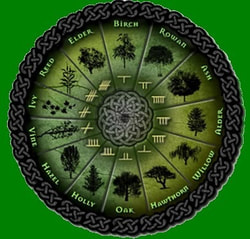
This page presents all things herbal and represents the "Green Way" of thinking about magick. I lean toward a Celtic view of things.
According to the High Medieval Bríatharogam, names of various trees can be ascribed to individual letters. Each of them have a symbol, which is called Ogham (OM). The etymology of the word ogam or ogham remains unclear. One possible origin is from the Irish og-úaim 'point-seam', referring to the seam made by the point of a sharp weapon. We start here with 13 trees that represent the phases of the year that are commonly known in our modern times as months. To enhance your understanding of this set of symbols, keep in mind that each tree symbol represents a whole set of characteristics and these then were applied to oral and written communication by the people who used them. For example, if I were trying to describe someone's personality I might say, or write the symbol for Birch to let you know that this individual was very hardy, protective, warm (this wood will burn wet),and nurturing. How efficient is that?!? All that with just one little Ogham symbol and the Druids even used a form of sign language by placing their fingers on the bridge of their nose to communicate without speech, as the Druids did when they wanted to communicate secretly around others who didn't know the language!
Also, keep in mind that Trees were sacred to our ancient peoples. As you read what the symbols mean below you will note a distinct sacred and eloquent feel to each. Ancient people did not separate their spirituality from their daily lives. They lived their spirituality.
According to the High Medieval Bríatharogam, names of various trees can be ascribed to individual letters. Each of them have a symbol, which is called Ogham (OM). The etymology of the word ogam or ogham remains unclear. One possible origin is from the Irish og-úaim 'point-seam', referring to the seam made by the point of a sharp weapon. We start here with 13 trees that represent the phases of the year that are commonly known in our modern times as months. To enhance your understanding of this set of symbols, keep in mind that each tree symbol represents a whole set of characteristics and these then were applied to oral and written communication by the people who used them. For example, if I were trying to describe someone's personality I might say, or write the symbol for Birch to let you know that this individual was very hardy, protective, warm (this wood will burn wet),and nurturing. How efficient is that?!? All that with just one little Ogham symbol and the Druids even used a form of sign language by placing their fingers on the bridge of their nose to communicate without speech, as the Druids did when they wanted to communicate secretly around others who didn't know the language!
Also, keep in mind that Trees were sacred to our ancient peoples. As you read what the symbols mean below you will note a distinct sacred and eloquent feel to each. Ancient people did not separate their spirituality from their daily lives. They lived their spirituality.
The Thirteen Trees of the Ogham Moon Calendar
*Note: Please understand that this page is a work in progress. I will eventually get all of the trees posted.
|
Birch
24th Dec - 20th Jan Rowan 21st Jan - 17th Feb Ash 18th Feb - 17th March Alder 18th March - 14th Apr Willow 15th Apr - 12th May Hawthorn 13th May - 9th June Oak 10th June - 7th July |
Holly
8th July - 4th Aug Hazel 5th Aug - 1st Sep Bramble 2nd Sep - 29th Sep Ivy 30th Sep - 27th Oct Wheatstraw / Reed 28th Oct - 24th Nov Elder 25th Nov - 22nd Dec |
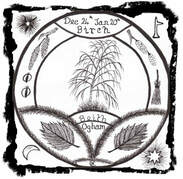
Original artwork © Ruby Clark 2011
Beith is the Irish name of the first letter of the Ogham alphabet, ᚁ, meaning "birch". In Old Irish, the letter name was Beithe, which is related to Welsh bedw(en), Breton bezv(enn), and Latin betula. Its Proto-Indo-European root was *gʷet- 'resin, gum'. Its phonetic value is [b].
The Auraicept na n-Éces contains the tale of the mythological origins of Beith[1]
“This moreover is the first thing that was written by Ogham, [illustration of seven b's, in Ogham script] i.e. (the birch) b was written, and to convey a warning to Lug son of Ethliu it was written respecting his wife lest she should be carried away from him into faeryland, to wit, seven b’s in one switch of birch: Thy wife will be seven times carried away from thee into faeryland or into another country, unless birch guard her." On that account, moreover, b, birch, takes precedence, for it is in birch that Ogham was first written. Reference: https://en.wikipedia.org/wiki/Beith_(letter)
Birch: Powers: Purification, Guardian of New Beginnings, Bringer of Hope, Channeler of Emotion,Protection.
The Druid tree symbol for the Bards - ‘The Goddess Tree’ - ‘The Lady of the Woods’, the Birch tree, Betula Pendula is the bringer of promise, light and new beginnings.
An elegant native of British woods, of all Northern European countries and of North America, the birch is tall, up to sixty or so meters in height, with a slender pale trunk. It grows in clearings, preferring sunlight, but is not fussy about soil and is very hardy although not especially long lived. The birch is known as a ‘Pioneer Tree’ – meaning that it can restart the colonization of woodlands after long term natural disasters. Its soft green deciduous leaves have serrated edges and are held on thin branches which move and bow in the breeze. Its striking white, peeling bark gives it a faery-like beauty in all its seasons. As the sap rises in early March, it’s possible to cut the bark, tap the trees and use the sweet liquid collected neat and cold as a water, or as the basis for a birch wine or beer.
Beith is the Irish name of the first letter of the Ogham alphabet, ᚁ, meaning "birch". In Old Irish, the letter name was Beithe, which is related to Welsh bedw(en), Breton bezv(enn), and Latin betula. Its Proto-Indo-European root was *gʷet- 'resin, gum'. Its phonetic value is [b].
The Auraicept na n-Éces contains the tale of the mythological origins of Beith[1]
“This moreover is the first thing that was written by Ogham, [illustration of seven b's, in Ogham script] i.e. (the birch) b was written, and to convey a warning to Lug son of Ethliu it was written respecting his wife lest she should be carried away from him into faeryland, to wit, seven b’s in one switch of birch: Thy wife will be seven times carried away from thee into faeryland or into another country, unless birch guard her." On that account, moreover, b, birch, takes precedence, for it is in birch that Ogham was first written. Reference: https://en.wikipedia.org/wiki/Beith_(letter)
Birch: Powers: Purification, Guardian of New Beginnings, Bringer of Hope, Channeler of Emotion,Protection.
The Druid tree symbol for the Bards - ‘The Goddess Tree’ - ‘The Lady of the Woods’, the Birch tree, Betula Pendula is the bringer of promise, light and new beginnings.
An elegant native of British woods, of all Northern European countries and of North America, the birch is tall, up to sixty or so meters in height, with a slender pale trunk. It grows in clearings, preferring sunlight, but is not fussy about soil and is very hardy although not especially long lived. The birch is known as a ‘Pioneer Tree’ – meaning that it can restart the colonization of woodlands after long term natural disasters. Its soft green deciduous leaves have serrated edges and are held on thin branches which move and bow in the breeze. Its striking white, peeling bark gives it a faery-like beauty in all its seasons. As the sap rises in early March, it’s possible to cut the bark, tap the trees and use the sweet liquid collected neat and cold as a water, or as the basis for a birch wine or beer.
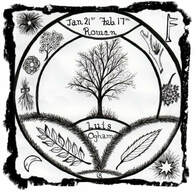
Original artwork © Ruby Clark 2011
Rowan - Luis Ogham letter L
Ruler of the 2nd Lunar Month 21st January - 17th February
Powers: Healing, Success and Power, Protection, Psychic Intuition.
The magical Rowan – a white-flowered faery tree. Sacred for the ancient Druid cults as Li sula, delight of the eye and Luis, the quicken tree, second ruler in the Ogham Tree Calendar. In its ruling time at the beginning of February, falls one of the four great pagan sabbats of the year – Imbolc (Feb 1st), American Groundhog Day, or Candlemas (Feb 2nd) in the Christian almanac. The Sisters of Avalon, a Welsh Celtic Tradition, celebrate the ancient custom of Gwyl Mair on the Full Moon during this time. The name ‘Rowan’ may have been passed down from the old Norse name for the tree ‘Runa’ which means a charm, or the Swedish ‘Roon’ for red. As well as being known as the Mountain Ash, its folk names are many and varied, Wicken Tree, Quickenwood, Quickbane, Sorbapple, Witchenwood, Rune Tree, Witchbane and Whitty Tree, being but a few!
The botanical name Sorbus Aucuparia is interesting, in that ‘aucuparia’ shows the tree has fruit which can be used by the ‘auceps’ or bird catcher to bait his traps.
The tree is widespread in Europe, China and Russia growing in the wild places where soil may be slightly peaty and acidic, the rocks and streams of the high moors and mountains. It’s a true native in the rocky habitats of Wales and Scotland and can withstand poor soil and icy temperatures. The rowan loves light and space, and as it is a small, fairly short lived tree, not reaching much above 15 metres it doesn’t grow in the old woodlands or forests where it would be overshadowed by the oaks and pines. As a wonderfully vivid, colourful and small tree, it’s a popular choice in modern urban settings, parks and open roadsides, which is fortunate for those living in the south, as it rarely grows there any longer in the wild.
In many parts of Europe they are still commonly found around the ruins of ancient settlements and stone circles. Were they planted deliberately, as magical protection, or was it that the stone circles and cairns were so often in the high, deserted habitats that the rowan likes best? Answer unknown!
The Rowan is loved for its pretty creamy-white clusters of flowers in May, whose sweet scent attracts plenty of bees and other pollinating insects. Its deciduous leaves are very much like those of the Ash, leaflets paired on a long central stem, which turn red in late autumn and that is where the tree found its other name of Mountain Ash, although not a member of the Ash family. Large bunches of brilliantly bright, red or orange berries hang down from late August, contrasting with the deep green of the long leaves. They can be made into a delicious jelly, often mixed with apple or crab-apples, which goes very well with game birds like pheasant or partridge, or with rabbit pies and venison. The fruits are coveted by the birds. Redwings and fieldfares descend on it in flocks in the mountains of Scotland, while the berries are stripped with relish in towns and gardens by blackbirds and chaffinches, who then disperse the seeds in their droppings.
The strong, dense light brown wood is prized by contemporary wood carvers and turners for its fine grain, and crafted into bowls, platters and stemmed cups. It was the traditional wood for spinning wheels, for large pegs and pins to fasten, for spindles and makes a fine walking stick. In the past Rowan wood was used in the making of many a farm tool handle, wheel-spoke and animal yolk, where it was considered to offer protection from witchcraft. A black dye can be extracted from the young tree bark, which contains much tannin.
Rowan - Luis Ogham letter L
Ruler of the 2nd Lunar Month 21st January - 17th February
Powers: Healing, Success and Power, Protection, Psychic Intuition.
The magical Rowan – a white-flowered faery tree. Sacred for the ancient Druid cults as Li sula, delight of the eye and Luis, the quicken tree, second ruler in the Ogham Tree Calendar. In its ruling time at the beginning of February, falls one of the four great pagan sabbats of the year – Imbolc (Feb 1st), American Groundhog Day, or Candlemas (Feb 2nd) in the Christian almanac. The Sisters of Avalon, a Welsh Celtic Tradition, celebrate the ancient custom of Gwyl Mair on the Full Moon during this time. The name ‘Rowan’ may have been passed down from the old Norse name for the tree ‘Runa’ which means a charm, or the Swedish ‘Roon’ for red. As well as being known as the Mountain Ash, its folk names are many and varied, Wicken Tree, Quickenwood, Quickbane, Sorbapple, Witchenwood, Rune Tree, Witchbane and Whitty Tree, being but a few!
The botanical name Sorbus Aucuparia is interesting, in that ‘aucuparia’ shows the tree has fruit which can be used by the ‘auceps’ or bird catcher to bait his traps.
The tree is widespread in Europe, China and Russia growing in the wild places where soil may be slightly peaty and acidic, the rocks and streams of the high moors and mountains. It’s a true native in the rocky habitats of Wales and Scotland and can withstand poor soil and icy temperatures. The rowan loves light and space, and as it is a small, fairly short lived tree, not reaching much above 15 metres it doesn’t grow in the old woodlands or forests where it would be overshadowed by the oaks and pines. As a wonderfully vivid, colourful and small tree, it’s a popular choice in modern urban settings, parks and open roadsides, which is fortunate for those living in the south, as it rarely grows there any longer in the wild.
In many parts of Europe they are still commonly found around the ruins of ancient settlements and stone circles. Were they planted deliberately, as magical protection, or was it that the stone circles and cairns were so often in the high, deserted habitats that the rowan likes best? Answer unknown!
The Rowan is loved for its pretty creamy-white clusters of flowers in May, whose sweet scent attracts plenty of bees and other pollinating insects. Its deciduous leaves are very much like those of the Ash, leaflets paired on a long central stem, which turn red in late autumn and that is where the tree found its other name of Mountain Ash, although not a member of the Ash family. Large bunches of brilliantly bright, red or orange berries hang down from late August, contrasting with the deep green of the long leaves. They can be made into a delicious jelly, often mixed with apple or crab-apples, which goes very well with game birds like pheasant or partridge, or with rabbit pies and venison. The fruits are coveted by the birds. Redwings and fieldfares descend on it in flocks in the mountains of Scotland, while the berries are stripped with relish in towns and gardens by blackbirds and chaffinches, who then disperse the seeds in their droppings.
The strong, dense light brown wood is prized by contemporary wood carvers and turners for its fine grain, and crafted into bowls, platters and stemmed cups. It was the traditional wood for spinning wheels, for large pegs and pins to fasten, for spindles and makes a fine walking stick. In the past Rowan wood was used in the making of many a farm tool handle, wheel-spoke and animal yolk, where it was considered to offer protection from witchcraft. A black dye can be extracted from the young tree bark, which contains much tannin.
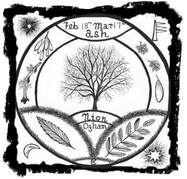
Original artwork © Ruby Clark 2011
Ash-Nion Ogham letter N
Ruler of the 3rd Lunar Month 18th February - 17th March
Powers: Protection, Health, Courage, and
matters concerning the Sea.
'Of all the trees in England,
Her sweet three corners in,
Only the Ash, the bonnie Ash
Burns fierce while it is green.'
From 'Trees' by Walter de la Mare
Ash-Nion Ogham letter N
Ruler of the 3rd Lunar Month 18th February - 17th March
Powers: Protection, Health, Courage, and
matters concerning the Sea.
'Of all the trees in England,
Her sweet three corners in,
Only the Ash, the bonnie Ash
Burns fierce while it is green.'
From 'Trees' by Walter de la Mare
Ash Myth, Religion, Spirituality and Folklore
Element: Fire Ruling Planet: Sun Gender: Masculine
Ash, called 'Uisinn' in Gaelic - 'Ask' in Norse and 'Esh' in Celtic - is the tree known as
‘The World Tree Yggdrasil’(pronounced igg-drah-sill, emphasis on the first syllable) of Norse Mythology. Sometimes called ‘The Tree of Life.’
Viking warriors were known as the Aescling – the Men of the Ash, most likely because of their mastery of battle spears made from ash wood.
The folk tale most closely associated with ash is a creation story from Norse mythology, telling of how the God Odin made the world, the underworld and the heavens, and in the centre, supporting the three, grew the ash tree Yggdrasil.
The name of the mythical tree is believed to have come from one of Odin’s other names ‘Yggr’, which itself would seem to be based on the Greek ‘hygra’ – the sea.
Odin hung on the boughs of Yggdrasil for nine days and nights, a self-imposed torture for which he was given eighteen runes and the knowledge of reading the rune-castings. You can read about this in the Poetic Edda, in a long poem entitled 'The Hávamál'.
'Yggdrasil' from 'Eddalaeren Vol.1' Finn Magnussen 1824
The British ash god was Gwydion, and in Welsh folklore his wand of enchantment was made from ash. In tales of Ireland, before the coming of Christianity there were five magical trees known as the ‘Chieftain Trees’, of these five, three were ash – The Tree of Usnech, The Tree of Dathi and the Tree of Tortu. They were felled in the 7th century AD as a symbol of the death of the pagan cults.
Here is a powerful description of the legendary tree from the Scottish writer Thomas Carlyle, from a series of lectures given in 1837
‘On Heroes, Hero-worship and the Heroic in History Pt 1’
“It came from the thoughts of Norse men ……..
All Life is figured by them as a Tree. Igdrasil, the Ash-tree of Existence, has its roots deep down in the kingdoms of Hela or Death; its trunk reaches up heaven-high, spreads its boughs over the whole Universe: it is the Tree of Existence.
At the foot of it, in the Death-kingdom, sit Three Nornas, Fates,--the Past, Present, Future; watering its roots from the Sacred Well. Its "boughs," with their buddings and disleafings --events, things suffered, things done, catastrophes,--stretch through all lands and times.
Is not every leaf of it a biography, every fibre there an act or word? Its boughs are Histories of Nations. The rustle of it is the noise of Human Existence, onwards from of old. It grows there, the breath of Human Passion rustling through it;--or storm tost, the storm-wind howling through it like the voice of all the gods. It is Igdrasil, the Tree of Existence.
It is the past, the present, and the future; what was done, what is doing, what will be done; "the infinite conjugation of the verb To Do."
British Ash Mythology: Ash rules the third part of the Celtic Ogham calendar, a time of rain, cold and flooding and in Britain, there are many place names with the syllable ‘Ask’ – the Norse word for As, for example: – Askrigg in Yorkshire, Port Askaig in Argyllshire, Askham in Furness in Lancashire.
The 'Ash Faggot' to be burned in some of the West Country of England on the YuleFire (December 21st), was a bundle of ash branches, carefully chosen and bound around with nine twines of long, flexible green ash stems, taken from where the trees have been pollarded. The log was rolled into the hall and pushed on to the already burning fire. When these green twines burned through with a bang and released the log, it was time to serve the hot cider Wassail bowl to the gathered family and friends.
The Ash Tree - Fraxinus Excelsior – Yggdrasil - The Great World Tree in the mythology of Odin and our Viking ancestors – is revered and full of magick.
The only one of the olive family (apart from privet) that's native to Britain, the Ash is a common sight in most of Europe. It can grow to a height of 150 feet (45 metres) and has a beautiful shape when allowed to grow in enough space to show off its full size and spread, and can live for hundreds of years. As Ash is such a useful timber, much grown for coppicing, so we don’t see fully grown trees with a single trunk very often.
Ash is a very easy tree to recognize in winter even when its long, feathery leaves have fallen. Bunches of single, brown winged seeds known as samara or ash keys, still cling below the branches and don’t fall until spring. Walk closer and you'll see large buds of purest black along the sides and tips of the twigs. Ash keys in winter Ash flowers bud in winter.
The ash flower breaks from the black bud in mid - March.
During the summer months, the Ash bears big, compound leaves up to 10 inches or about 25cm long. These are made up of between four and six pairs of slightly serrated leaflets, evenly spaced along the central stem, with a single one at the top end. The black buds seen so clearly in winter break into flower in late April, before the leaves arrive. They are small tufts of greenish and purple fronds, male, female or both from year to year - all stamens and pistils, with no petals, and are very attractive to the spring pollinating insects. the flower bases will eventually swell and ripen into the ash keys, carried from late summer and blown away to propagate the following spring.
Ash bark is a soft greyish brown,smooth in young trees, getting rougher and more gnarled with age and girth.
Its timber is still a valuable commodity, being dense and strong making it quite hard to cut but also hard to break. In times gone by, when wood was more in demand, Ash was a mainstay of bows and spears, later in wheel axles, carriages and wagons, gates and in endless types of agricultural tools. Ash wood still makes the best oars – a piece of timber large enough to make a good-sized oar would take about twenty years to grow.It is still used in carriage making. Plates and bowls,etc., made from Ash can be polished to a high shine. When it is young it’s springy and flexible, growing quickly and coppiced wood (known as Ground Ash) can be harvested every ten years - Ash poles are always in great demand. Hop poles are still made from Ash, but sadly the hop fields are now few and far between even in Kent. Because of its great strength, lightness and elasticity, it was, and is, used to build the framework of the beautiful British Morgan sports cars. An American review for the all new Morgan Aero8 back in 2000 says,
‘The body panels are also aluminium, but they are still mounted on an ash frame - kiln-dried Belgian ash - the way Morgan's have been built for decades.’
The main use for ash timber nowadays is for fuel as it makes a wonderful log for burning, lasting a long time and giving virtually no smoke or spitting, even when burned green.
The grey ash left behind is a fine source of potash for gardeners. The Latin species ‘Fraxinus’ name actually means ‘firelight’.
Element: Fire Ruling Planet: Sun Gender: Masculine
Ash, called 'Uisinn' in Gaelic - 'Ask' in Norse and 'Esh' in Celtic - is the tree known as
‘The World Tree Yggdrasil’(pronounced igg-drah-sill, emphasis on the first syllable) of Norse Mythology. Sometimes called ‘The Tree of Life.’
Viking warriors were known as the Aescling – the Men of the Ash, most likely because of their mastery of battle spears made from ash wood.
The folk tale most closely associated with ash is a creation story from Norse mythology, telling of how the God Odin made the world, the underworld and the heavens, and in the centre, supporting the three, grew the ash tree Yggdrasil.
The name of the mythical tree is believed to have come from one of Odin’s other names ‘Yggr’, which itself would seem to be based on the Greek ‘hygra’ – the sea.
Odin hung on the boughs of Yggdrasil for nine days and nights, a self-imposed torture for which he was given eighteen runes and the knowledge of reading the rune-castings. You can read about this in the Poetic Edda, in a long poem entitled 'The Hávamál'.
'Yggdrasil' from 'Eddalaeren Vol.1' Finn Magnussen 1824
The British ash god was Gwydion, and in Welsh folklore his wand of enchantment was made from ash. In tales of Ireland, before the coming of Christianity there were five magical trees known as the ‘Chieftain Trees’, of these five, three were ash – The Tree of Usnech, The Tree of Dathi and the Tree of Tortu. They were felled in the 7th century AD as a symbol of the death of the pagan cults.
Here is a powerful description of the legendary tree from the Scottish writer Thomas Carlyle, from a series of lectures given in 1837
‘On Heroes, Hero-worship and the Heroic in History Pt 1’
“It came from the thoughts of Norse men ……..
All Life is figured by them as a Tree. Igdrasil, the Ash-tree of Existence, has its roots deep down in the kingdoms of Hela or Death; its trunk reaches up heaven-high, spreads its boughs over the whole Universe: it is the Tree of Existence.
At the foot of it, in the Death-kingdom, sit Three Nornas, Fates,--the Past, Present, Future; watering its roots from the Sacred Well. Its "boughs," with their buddings and disleafings --events, things suffered, things done, catastrophes,--stretch through all lands and times.
Is not every leaf of it a biography, every fibre there an act or word? Its boughs are Histories of Nations. The rustle of it is the noise of Human Existence, onwards from of old. It grows there, the breath of Human Passion rustling through it;--or storm tost, the storm-wind howling through it like the voice of all the gods. It is Igdrasil, the Tree of Existence.
It is the past, the present, and the future; what was done, what is doing, what will be done; "the infinite conjugation of the verb To Do."
British Ash Mythology: Ash rules the third part of the Celtic Ogham calendar, a time of rain, cold and flooding and in Britain, there are many place names with the syllable ‘Ask’ – the Norse word for As, for example: – Askrigg in Yorkshire, Port Askaig in Argyllshire, Askham in Furness in Lancashire.
The 'Ash Faggot' to be burned in some of the West Country of England on the YuleFire (December 21st), was a bundle of ash branches, carefully chosen and bound around with nine twines of long, flexible green ash stems, taken from where the trees have been pollarded. The log was rolled into the hall and pushed on to the already burning fire. When these green twines burned through with a bang and released the log, it was time to serve the hot cider Wassail bowl to the gathered family and friends.
The Ash Tree - Fraxinus Excelsior – Yggdrasil - The Great World Tree in the mythology of Odin and our Viking ancestors – is revered and full of magick.
The only one of the olive family (apart from privet) that's native to Britain, the Ash is a common sight in most of Europe. It can grow to a height of 150 feet (45 metres) and has a beautiful shape when allowed to grow in enough space to show off its full size and spread, and can live for hundreds of years. As Ash is such a useful timber, much grown for coppicing, so we don’t see fully grown trees with a single trunk very often.
Ash is a very easy tree to recognize in winter even when its long, feathery leaves have fallen. Bunches of single, brown winged seeds known as samara or ash keys, still cling below the branches and don’t fall until spring. Walk closer and you'll see large buds of purest black along the sides and tips of the twigs. Ash keys in winter Ash flowers bud in winter.
The ash flower breaks from the black bud in mid - March.
During the summer months, the Ash bears big, compound leaves up to 10 inches or about 25cm long. These are made up of between four and six pairs of slightly serrated leaflets, evenly spaced along the central stem, with a single one at the top end. The black buds seen so clearly in winter break into flower in late April, before the leaves arrive. They are small tufts of greenish and purple fronds, male, female or both from year to year - all stamens and pistils, with no petals, and are very attractive to the spring pollinating insects. the flower bases will eventually swell and ripen into the ash keys, carried from late summer and blown away to propagate the following spring.
Ash bark is a soft greyish brown,smooth in young trees, getting rougher and more gnarled with age and girth.
Its timber is still a valuable commodity, being dense and strong making it quite hard to cut but also hard to break. In times gone by, when wood was more in demand, Ash was a mainstay of bows and spears, later in wheel axles, carriages and wagons, gates and in endless types of agricultural tools. Ash wood still makes the best oars – a piece of timber large enough to make a good-sized oar would take about twenty years to grow.It is still used in carriage making. Plates and bowls,etc., made from Ash can be polished to a high shine. When it is young it’s springy and flexible, growing quickly and coppiced wood (known as Ground Ash) can be harvested every ten years - Ash poles are always in great demand. Hop poles are still made from Ash, but sadly the hop fields are now few and far between even in Kent. Because of its great strength, lightness and elasticity, it was, and is, used to build the framework of the beautiful British Morgan sports cars. An American review for the all new Morgan Aero8 back in 2000 says,
‘The body panels are also aluminium, but they are still mounted on an ash frame - kiln-dried Belgian ash - the way Morgan's have been built for decades.’
The main use for ash timber nowadays is for fuel as it makes a wonderful log for burning, lasting a long time and giving virtually no smoke or spitting, even when burned green.
The grey ash left behind is a fine source of potash for gardeners. The Latin species ‘Fraxinus’ name actually means ‘firelight’.
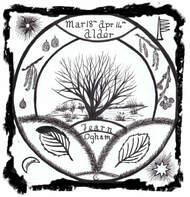
Original artwork © Ruby Clark 2011
Alder Healing and Medicine
Alder from Gerrard’s Herball 1597 The short description in John Gerrard’s Herball of 1597 tells us that: the leaves and bark are much used against hot swellings, ulcers and all inward inflammations, especillay of the Almonds and kernels of the throat. The bark is much used of poor country diers, for the dying of course cloth, caps, hose and such like into a black colour,whereunto it serveth very well.'
Using the leaves alone, a paste made of crushed leaves was useful when spread on to burns and a cloth bag, filled with alder leaves and warmed, was said to alleviate the aches of rheumatism and muscular back pain, or to dry breast milk. The cones were used in the west country to brew a drink which apparently cured gout.
The juice from fresh green under-bark was mixed with goose grease and smeared on the chest for relief of colds. Native American Indians used the bark from the roots as a more powerful alternative, which was also drunk as an emetic and a purge.
The fresh, young leaves are slightly sticky, and were hung in bunches in the kitchen, or strewn on the floor of chicken sheds or dog kennels to attract and catch insect pests.
Still used in herbal medicine as an astringent, the inner green bark is stripped out and simmered until very soft. This is left to stand for a few hours or overnight and then strained. The liquid is used as a wound-wash, or soaked into a poultice and applied to a wound or swelling externally.
This decoction, or the fresh juice squeezed from green bark and leaves can also be used as a wash to relieve itching in athlete’s foot type of fungal infections and on skin rashes
A tea made from the leaves and / or bark may relieve symptoms in any thoat infection including tonsillitis. It's very easy to do yourself.
It is bitter tasting, so adding a little honey can be useful with any throat problem. This tea, strained and cold can be used as a gargle for sore throats and a wash for mouth ulcers and sore gums.
from Robert Graves' version of 'Cad Goddeu' -'The Battle of the Trees'
Alder Healing and Medicine
Alder from Gerrard’s Herball 1597 The short description in John Gerrard’s Herball of 1597 tells us that: the leaves and bark are much used against hot swellings, ulcers and all inward inflammations, especillay of the Almonds and kernels of the throat. The bark is much used of poor country diers, for the dying of course cloth, caps, hose and such like into a black colour,whereunto it serveth very well.'
Using the leaves alone, a paste made of crushed leaves was useful when spread on to burns and a cloth bag, filled with alder leaves and warmed, was said to alleviate the aches of rheumatism and muscular back pain, or to dry breast milk. The cones were used in the west country to brew a drink which apparently cured gout.
The juice from fresh green under-bark was mixed with goose grease and smeared on the chest for relief of colds. Native American Indians used the bark from the roots as a more powerful alternative, which was also drunk as an emetic and a purge.
The fresh, young leaves are slightly sticky, and were hung in bunches in the kitchen, or strewn on the floor of chicken sheds or dog kennels to attract and catch insect pests.
Still used in herbal medicine as an astringent, the inner green bark is stripped out and simmered until very soft. This is left to stand for a few hours or overnight and then strained. The liquid is used as a wound-wash, or soaked into a poultice and applied to a wound or swelling externally.
This decoction, or the fresh juice squeezed from green bark and leaves can also be used as a wash to relieve itching in athlete’s foot type of fungal infections and on skin rashes
A tea made from the leaves and / or bark may relieve symptoms in any thoat infection including tonsillitis. It's very easy to do yourself.
It is bitter tasting, so adding a little honey can be useful with any throat problem. This tea, strained and cold can be used as a gargle for sore throats and a wash for mouth ulcers and sore gums.
from Robert Graves' version of 'Cad Goddeu' -'The Battle of the Trees'
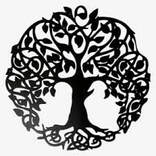
Willow Tree Symbolism and Celtic Meaning According to the Ancient Ogham
Sail or Saille is the Irish name of the fourth letter of the Ogham alphabet, ᚄ meaning "willow".
The name is related to Welsh helyg(en) and Latin salix. Its Proto-Indo-European root was *sal-. Its phonetic value is [s].
In the medieval kennings, called Bríatharogam or Word Ogham the verses associated with sail are:
lí ambi - "pallor of a lifeless one" (Word Ogham of Morann mic Moín)
lúth bech - "sustenance of bees" (Word Ogham of Mac ind Óc)
tosach mela - "beginning of honey" (Word Ogham of Culainn)[1]
Reference: https://en.wikipedia.org/wiki/Sail_(letter)
The Celtic meaning of willow has a long history of symbolism associated with metaphysical and ritual practices. Specifically, the willow wood has been (and still is) used in ceremonies intended for enhancement of psychic abilities, honoring the moon as well as increase the essence of love in our lives. Many uses and associations came be traced back to our Celtic ancestors’ observations of the willow tree in their natural environment. Druid priests, dryads (priestesses), bards and ovates all recognized the willow’s affinity to watery domains. Flora and fauna in close connection with water are considered dwellers of the psychic realm, and symbolic of inspired imagination. The willow gets its moon associations (another powerful symbol of psychic and intuitive energy) because of its relationship to water. We see this when we recognize the moon’s influence over the waters of the earth – it moves the tides, pulling fluids to and fro with her own wax and wane. Recognizing these natural unions, ancient Celtic spiritual leaders considered the willow a container for water/moon attributes and thus utilized its wood and branches to invoke deeper connections to their intuitive purposes. The Celts understood that the willow was instrumental in bringing about psychic visions that produced a clearer understanding of the world in which they lived.
www.whats-your-sign.com/celtic-meaning-willow-tree.html
Sail or Saille is the Irish name of the fourth letter of the Ogham alphabet, ᚄ meaning "willow".
The name is related to Welsh helyg(en) and Latin salix. Its Proto-Indo-European root was *sal-. Its phonetic value is [s].
In the medieval kennings, called Bríatharogam or Word Ogham the verses associated with sail are:
lí ambi - "pallor of a lifeless one" (Word Ogham of Morann mic Moín)
lúth bech - "sustenance of bees" (Word Ogham of Mac ind Óc)
tosach mela - "beginning of honey" (Word Ogham of Culainn)[1]
Reference: https://en.wikipedia.org/wiki/Sail_(letter)
The Celtic meaning of willow has a long history of symbolism associated with metaphysical and ritual practices. Specifically, the willow wood has been (and still is) used in ceremonies intended for enhancement of psychic abilities, honoring the moon as well as increase the essence of love in our lives. Many uses and associations came be traced back to our Celtic ancestors’ observations of the willow tree in their natural environment. Druid priests, dryads (priestesses), bards and ovates all recognized the willow’s affinity to watery domains. Flora and fauna in close connection with water are considered dwellers of the psychic realm, and symbolic of inspired imagination. The willow gets its moon associations (another powerful symbol of psychic and intuitive energy) because of its relationship to water. We see this when we recognize the moon’s influence over the waters of the earth – it moves the tides, pulling fluids to and fro with her own wax and wane. Recognizing these natural unions, ancient Celtic spiritual leaders considered the willow a container for water/moon attributes and thus utilized its wood and branches to invoke deeper connections to their intuitive purposes. The Celts understood that the willow was instrumental in bringing about psychic visions that produced a clearer understanding of the world in which they lived.
www.whats-your-sign.com/celtic-meaning-willow-tree.html
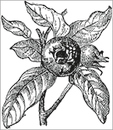
Hawthorn
Legend associates this plant with fairies, although the nature of that association seems to vary from source to source. Hawthorn is said to protect against fairies and conversely to bring fairies into the house. It is believed to be exceptionally unlucky to bring the flowers of the hawthorn into the home or to a gather hawthorn before the first week of May. It also offers protection against lightning. Hawthorn’s thorns are used in some candle spells in which a device like a waxing moon or pentagram is drawn on wax with the thorn itself. ~The Witch's Almanac~
- Uath, Old Irish Úath means úath "horror, fear", the arboreal tradition has "white-thorn". The original etymology of the name, and the letter's value, are however unclear. McManus (1986) suggested a value [y]. Peter Schrijver (see McManus 1991:37) suggested that if úath "fear" is cognate with Latin pavere, a trace of PIE *p might have survived into Primitive Irish, but there is no independent evidence for this. https://en.wikipedia.org/wiki/Ogham
Legend associates this plant with fairies, although the nature of that association seems to vary from source to source. Hawthorn is said to protect against fairies and conversely to bring fairies into the house. It is believed to be exceptionally unlucky to bring the flowers of the hawthorn into the home or to a gather hawthorn before the first week of May. It also offers protection against lightning. Hawthorn’s thorns are used in some candle spells in which a device like a waxing moon or pentagram is drawn on wax with the thorn itself. ~The Witch's Almanac~
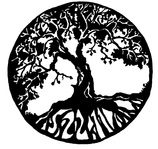
Oak
Carry an acorn in your pocket when you go to an interview or business meeting; it will be bring you good luck. If you catch a falling Oak leaf before it hits the ground, you'll stay healthy the following year.
- Dair, Old Irish Dair means "oak" (PIE *doru-).
Carry an acorn in your pocket when you go to an interview or business meeting; it will be bring you good luck. If you catch a falling Oak leaf before it hits the ground, you'll stay healthy the following year.
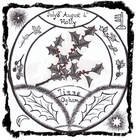
Original artwork © Ruby Clark 2010
Holly - Tinne Ogham letter T Ruler of the 8th Lunar Month
8th July - 4th August
Associated Festival - Lammas (Lughnasadh)
Powers: Protection,Luck, Psychic Enhancement (dreams)
Holly - Tinne Ogham letter T Ruler of the 8th Lunar Month
8th July - 4th August
Associated Festival - Lammas (Lughnasadh)
Powers: Protection,Luck, Psychic Enhancement (dreams)
